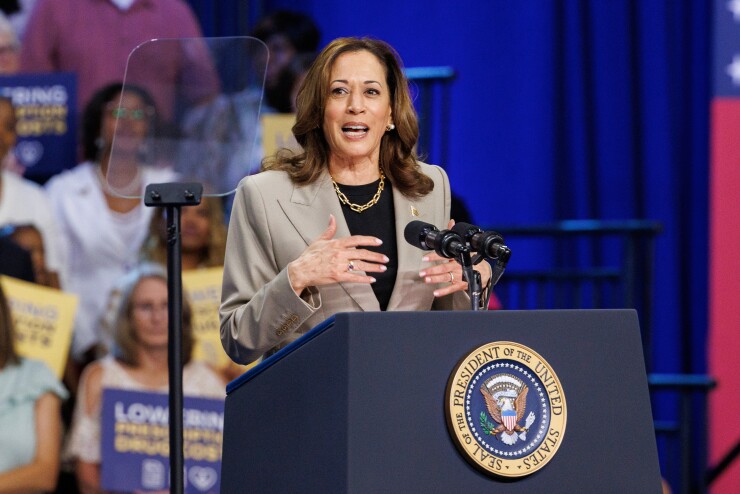
Vice President Kamala Harris has pledged to dramatically expand the housing supply
But many housing advocates are questioning whether those visions will ultimately align and make a meaningful impact on the affordable housing crisis.
"In terms of where the Vice President's coming from and where we're coming from, we know that there's not going to be a single solution to the housing affordability and supply crisis — it's never either/or, it needs to be yes/and, and we want to be part of it," said Ryan Donovan, president and CEO of the Council of Federal Home Loan Banks.
Harris's plan is focused, in part, on expanding the Low-Income Housing Tax Credit program, the federal program that provides tax credits to developers in exchange for building new affordable housing or reserving some portion of multifamily housing units for low-income households. The Federal Home Loan Banks contribute to the LIHTC program and also are working to expand support for Community Development Financial Institutions — mission-driven organizations aimed at lending and providing services to low- and moderate-income consumers — as well as other proposals in the same vein.
The Home Loan Banks held discussions this summer with the Treasury Department on what the system can do to have a bigger impact. Last month, the presidents of the 11 Home Loan Banks
Joe Neri, the CEO of IFF, a Chicago CDFI, who chairs a CDFI working group of the FHLBs, said CDFIs face many obstacles in accessing the system's low-cost funding. At issue are the so-called "haircuts," that the Home Loan Banks impose on the value of pledged collateral. Those haircuts can be upwards of 40%, which makes funding for housing development economically unfeasible, he said. Banks typically pledge collateral such as mortgages and commercial and residential mortgage-backed securities, but CDFI collateral can include more complex underwriting and thus be more difficult to appraise.
"The most important affordable housing program in the country is the Low-Income Housing Tax Credit Program," said Neri. "The only way that works is if the haircuts come down."
The Federal Housing Finance Agency, the system's regulator, issued a report last year,
Donovan agreed that lowering haircuts is a priority. He emphasized that a guarantee on CDFI advances also would change the risk profile of the collateral.
"The benefit would be more proceeds going to the CDFIs in the form of advances and they're able to use that money to help address housing affordability and supply," Donovan said. "There is a similar issue with LIHTC collateral. Everyone, I think, is in agreement, that this is generally very strong collateral — but because it's hard to value, it gets a substantial haircut."
The issue of collateral came up in a discussion on Thursday of federal policies at a Center For American Progress housing summit in Washington, D.C.
"As collateral to get a FHLB loan, maybe they ought to think more about giving preferences to multifamily housing, since multifamily housing tends to be smaller per yard and therefore cheaper and more accessible to the average American," said Bernard Fulton, vice president for housing policy and regulation at the National Multifamily Housing Council.
Roughly half of the system's affordable housing program grants are paired with the LIHTC program. A key problem with valuing collateral pledged for the LIHTC program is that institutions that originate and hold loans tend to keep them on their balance sheets in order to obtain the tax credits, Donovan said, so there is virtually no secondary market for the loans.
Expanding CDFI membership in the Home Loan Bank system would also help expand affordable housing. Only 75 of the roughly 600 eligible non-depository CDFIs in the country are members of the Home Loan Bank System, a private but government-sponsored cooperative funded by capital from its 6,500 members.
Donovan said the 11 regional Home Loan Banks are each working to bring in more innovative ideas to help solve the affordable housing crisis.
Last month, the
The Home Loan Banks also want to increase support of state housing finance agencies.
"The banks do very valuable work, and they're doing some special initiatives right now that I think are really helpful, but we and our members think that they can do more," said Garth Rieman, director of housing advocacy and strategic initiatives at the National Council of State Housing Agencies.
Reiman said there is "even more untapped potential for the Home Loan Banks to really make a significant contribution and difference in providing more affordable housing in their districts. There is much more opportunity for providing funds in a much more flexible way."
But there remains friction between the banks and efforts by the Biden administration and some Democratic lawmakers to push them do more on the affordable housing front.
Last month, the banks pushed back on
The banks also have
"What the Federal Home Loan Banks mission is, is to provide stable, long term capital for the housing needs of the nation," said Neri.
Housing experts think there needs to be at least 3-4 million homes or apartment units built to normalize the nation's housing supply. Others
The Home Loan banks have long billed themselves as among the largest providers of affordable housing, and say they
"For a new administration, working through the FHFA and thinking about the GSEs and the Federal Home Loan Banks will definitely provide an opportunity to try to do more in the affordable housing area," Rieman said. "Hopefully the affordable housing program and the bank's other activities will be a significant focus of the next administration, so I think it all makes sense in this presidential election context."






